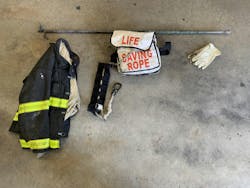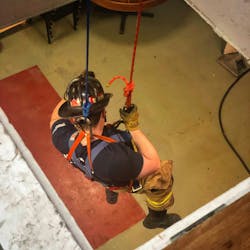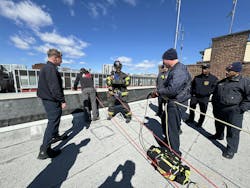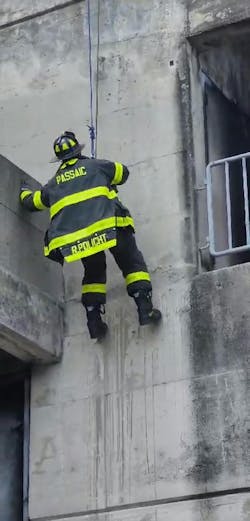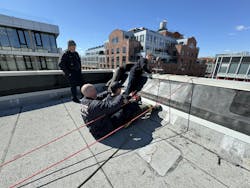Truck Tactics: Roof Rope Operations and Training
The roof rope is more than just a rope for a riding position on an apparatus. For decades, it’s been known as one of the highest risk and lowest frequency operations for firefighters in the Northeast. FDNY is iconic on how it trains on it. An image that pops into my head when discussing these operations is the iconic photograph of FDNY Firefighter Kevin Shea grabbing a victim in Manhattan in May 1991.
With the advent of cellphone photography and social media, roof rope/over-the-edge rescue operations are becoming publicized more frequently.
The operation may be broken down into numerous factors, but the most important parts to focus on is building construction and the operational efficiency of a company.
More than ‘equipment’
The roof rope is an overall package that must be understood from the command officer down to the firefighters who deploy the kit. This includes the mental and physical preparedness that must be embraced to set up yourself and your team for success should the kit need to be deployed.
It’s important to understand that the roof rope isn’t used just for operations that are carried out from a rooftop. It simply might be an operation that utilizes a rope from above a target location. Some might say that the roof rope is only for career departments that are adequately staffed. In reality, that isn’t the case. Many minimally or low-staffed departments are equipped and trained on these types of scenarios. Of course, every department has its own respective standard operating guidelines/standard operating procedures, and what works for one place might not work for another. Nevertheless, when lives are at risk, the task must be completed.
The anchor point
The roof rope operation involves sending a firefighter over the edge of a roof or a floor above to make a rescue of a victim and to lower the victim and the firefighter down to the street or floor below to a safer environment. This task can be broken down into tangible elements of the process.
The first and foremost decision that must be made is whether there is, in fact, a need to send a firefighter over to rescue someone. Sounds easy. We all do this job to make better days for those who are in need. However, in the fractions of a second of the size-up prior to transmitting the “send the rope over the edge” moment, incident commanders and firefighters must understand the conditions that they are presented with.
Traditionally, the roof rope was an answer to rescuing trapped individuals who presented to firefighters in windows or on balconies out of the reach of an aerial, in windowless light and air shafts, or in the rear of a building where no apparatus or ground ladders were established. One point of view on the roof rope is that firefighters create a temporary bailout line for victims who are presenting at windows, etc.
What must be done to set up the roof rope or rope from above? There are three distinct elements that are fulfilled.The first is to create the anchor point.
When dealing with a rooftop, a “bombproof” anchor should be used or created to anchor the rope. Sometimes, it takes the form of tying into an engineered anchor point, wrapping an HVAC unit, opening up the roof and wrapping a rafter, or burying a hand tool into the roof and tying into that. Each has pros and cons. Some are extremely reliable, such as the engineered anchor point on a roof. Some, such as burying a tool into the roof, can be of higher risk because of the uncertainty when loads potentially shift.
When all else fails and there’s some sort of stable or well-constructed parapet, the meat anchor also works. The meat anchor is the firefighter who not only controls the descent but also the load of the firefighter and potential victim who are going down on rope. When practiced and trained on multiple times, it could become the method of choice.
Another point to mention when utilizing ropes and particularly in the case of a meat anchor: The load on the rope is exponentially distributed on both the contact surface and at every edge/change in the rope. Without getting overly technical, the potential load that the anchor feels can be one-half or two-thirds of the weight.
Prior to the rope bag being flipped upside down, the firefighter who goes over the edge gets clipped/secured into the line and takes the edge protection to the targeted area. This is important, because, depending on the situation and the point of transition, the firefighter will be able to get over the edge guaranteeing the edge protection. This applies if there’s a separate inline edge protection. In some places, old mats or turnout coats are used as edge protection. Some suppliers offer items that are tied onto the rope with prusiks or cords.
Belaying
The second element of setting up for the controlled decent is to have the belaying firefighter tie into the line on the anchor side of the rope through the eyelet of the harness. If the belaying firefighter is anchored on the opposite side of the rope, that person has the potential to be part of the problem—i.e., taking an unfortunate descent while the weight of the rescuer who’s going over pulls the two of them over while all the deployable rope is behind them.
Belaying—or controlling or lowering or whatever you want to call it—is quite simple. The firefighter who is in control of this can use a descent device or simply a few wraps of the rope to the pompier hook on the harness or ladder belt to create friction to lower the rescuer.
Second set of eyes
The third element of the roof rope team is someone who calls the shots and maintains communications and contact with both the belay firefighter and the rescue firefighter. That position might not be the flashiest position, but it might be the most important one.
This firefighter serves as the second set of eyes for everything, clips the lowering firefighter in, checks the rope management, and double-checks the knots and orientation of the ropes in the descent devices or if they are simply wrapped. Simple commands, such as “lower,” “stop” and “victim on,” should be used.
All of this happens in fractions of a second, but it must be perfect. There are no second chances with this operation. One missed detail and someone could be killed or seriously injured.
The why?
Why is there a need for all fire departments to consider roof rope operations? Departments must be prepared to engage the operation, particularly with the building construction revolution that’s going on in the world. More and more buildings are being constructed taller, on a pedestal-style orientation, and, in some cases, in a unique position (i.e., wherever a developer can make it fit).
Many career departments are faced with developing a plan of attack with less staffing and higher stakes. Many volunteer departments must start to look at the potential of operating at this kind of incident. Many suburban and rural towns are witnessing the construction of taller buildings. In some cases, it may be a six-story, toothpick pedestal, residential-over-commercial development. In the event of an upper-floor fire where the aerial doesn’t reach, firefighters still must make the grab. In some cases, it might be a six-story building where there is only street access on one side that requires a drop from the fifth floor to grab someone off of the fourth floor.
Think of a unique scenario and try to talk through it on a drill night. Ultimately, consistent hands-on evolutions of the roof rope make everyone more proficient in the operation.
Standardize and schedule the training. In a volunteer department for which the potential is low, perhaps training once per month is enough. In a career department that serves a dense city for which the potential is higher, training once per week might be appropriate.
Commercially available kits
There are different options available for roof rope and rope-from-above kits. Many companies offer a very basic kit, which includes 150–200 feet of rope with edge protection and a couple of carabiners. Edge protection is available from CMC, RopeSafe and Strep Systems, among others.
Anderson Rescue Solutions (ARS) developed a breakout kit that’s designed to be, let’s say, firefighter-proof (i.e., minimal potential for messing up the deployment). The ARS kit utilizes 150 feet of half-inch rope, an ICS D5 descender, edge protection, carabiners and a specifically designed bag for streamlined deployment.
Recently, the roof rope was deployed by members of North Hudson Regional Fire and Rescue (NHRFR) in New Jersey at a fire in a high-rise residential building. Deputy Chief Alider Pratts explained that members deployed the bag and lowered a firefighter to the floor below to contact a victim who was able to get to the balcony. Aggressive interior operations quickly knocked down the fire, and the firefighter who was lowered to the fire apartment was able to shelter the victim until it was safe enough to remove the person through the fire apartment.
Training and preparedness
At the end of the day, it all comes down to training and preparedness. Firefighters must learn to trust their equipment and be proficient in their basic skills. Whether off the roof or from the floor above, there isn’t anything complex about these operations.
Assess the buildings that are in your community and neighboring jurisdictions. If there’s potential for roof rope rescue, start planning. Have the conversation. You can’t expect to pull off a roof rope rescue at 3 a.m. without ever training on the operation.
About the Author
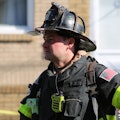
Robert Policht
Robert Policht, who is a Firehouse contributing editor, is lieutenant of Ladder Co. 2 of the Passaic, NJ, Fire Department. He assisted with developing and establishing the department’s response to human vs. machine incidents and is attached to the Fire Investigation Unit. Policht started his career as a volunteer and has served as a chief of department. He taught at the Bergen County, NJ, Fire Academy and is a member of the NJ Division of Fire Safety's Fire Threat Task Force. Policht has a master’s degree in emergency management and homeland security from Arizona State University and has been published in several trade publications. He is a founder of and contributor to Flow and Vent, which is a website that's dedicated to fire and rescue training.


